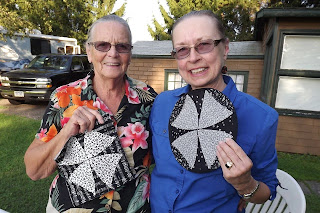I mentioned last week that I 'unearthed' a little
surprise stash of purple pinwheel blocks - about 150 of them! - when I was
packing for a quilt retreat not too long ago. I remembered making the blocks,
in fact I walked you through how I used a specialty ruler to make the
half-square triangle ruler from strips last week. You can read more about it here, if you'd like
a refresher.
Anyway, even though I remembered the blocks, I just forgot that I
never used them. And since purple is one of those fabric colors I can't pass up
when I'm in the local quilt shop, it would be a shame for these blocks to stay
stowed in a box on a bottom shelf. So, I decided these blocks wanted to become
a quilt.
So I found some purple coordinates in my stash. (I knew I bought those fabrics for a reason!) And cut them up in to 4-1/2" squares, same size as the pinwheel blocks. Three different fabrics, a medium/bold purple, a light lavender/purple, and an off-white. Then laid them out on a table, arranging the fabric squares and the pinwheel blocks alternately in rounds. Lightest fabric squares in the middle, darker fabrics in the outer round. And the medium stuff in the middle. And on point.
So I found some purple coordinates in my stash. (I knew I bought those fabrics for a reason!) And cut them up in to 4-1/2" squares, same size as the pinwheel blocks. Three different fabrics, a medium/bold purple, a light lavender/purple, and an off-white. Then laid them out on a table, arranging the fabric squares and the pinwheel blocks alternately in rounds. Lightest fabric squares in the middle, darker fabrics in the outer round. And the medium stuff in the middle. And on point.
Then I stacked up my blocks by row and sewed them
into rows.
To make the setting triangles, I went back to the
Small Diagonal Set Triangle Ruler from Marti Michell (it's already in the prize
package - Yay!). Picked out a dark purple from the stash. And cut strips for the sides, and cut the side setting triangles.
I made my strips large enough so the outer blocks would 'float.' I lined up he
ruler and cut one side . . .
. . . flipped the ruler, and cut the other
side. Making sure to align the bottom line on the ruler with the edge of the
fabric and the top blunt point with the bias cut edge of the fabric.
I used the tool to blunt the corners so they piece
together perfectly.
Then I cut my corner triangles from the larger strip.
(Yes, it's the same dark purple fabric, the color got a little strange for
these next couple photos - operator error (me), I'm sure.)
And blunted the corners.
With the blocks and fabric squares sewn, I just need
to lay out the pieced strips and add the triangles to the end of each row.
Then sew the rows together. It looks like the setting
triangles don't line up very well. In fact, they line up perfectly once they
are sewn to the rows.
What about a border? Absolutely! Let's do that next
time.
Purple Pinwheel Palooza to be continued!
The GREAT Summer Orphan Block Challenge
For those of you following the GREAT Summer Orphan Block Challenge,
Labor Day = the End of Summer, BUT there is still time to enter the challenge!
The deadline (September 21st, 2012, 11:59pm) is getting closer. Find an orphan
block or several in your stash and turn it into a project. Send before and
after pictures and tell the story of your project and you could be a grand
prize winner! Easy enough, right?!
Speaking of Prizes – The Taunton Press Weighs In!
The prize package for the GREAT Summer Orphan Block
Challenge continues to grow. The Taunton Press published my first book,
ScrapTherapy, Cut the Scraps! back in March 2011. And in April 2013, they'll be
releasing my second book, ScrapTherapy, Scraps Plus One!
When Taunton heard about the GREAT Summer Orphan
Block Challenge, they wanted to play, too. So, Taunton is adding some wonderful
new titles to the grand prize package. And such variety. There's something for
everyone here.
First in Kaffe Quilts Again,
Kaffe Fassett has taken twenty of his favorite quilts and updated them with new
fabrics. The beautiful photography of the quilts in rural Bulgaria makes this
sheer eye-candy for any quilter!
Next, we're adding the Kitchen and Bath Planning Guide.
While you're busy at the sewing machine, you can dream about your next bathroom
and kitchen upgrade with some inspiration from Fine Homebuilding. What a treat!
This magazine makes me want to call my plumber and grab a hammer!
Quilters love to cook. And quick and delicious seems
to be the way to go. Quick Fix Meals by Robin Miller
is chock full of simple, yummy recipes - 200 of them! - to give you energy to
sew. If you win the grand prize, just tell me what time, and I'll plan to pop
in for dinner!
More prizes from The Taunton Press will be announced
next time!
Happy Stitching!
Joan




















































